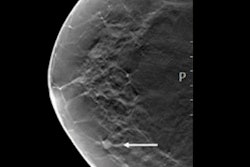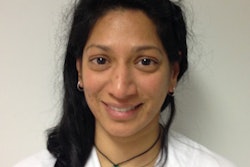
Interest in the pros and cons of double reading looks set to rise still further, following a new Norwegian study that found using expert second readers and targeting urgent cases showed double reading resulted in enough clinically important changes to case interpretation to support more widespread use of the technique.
 "There is still much to be done in the area of quality assurance of interpretation of imaging exams," Dr. Peter Lauritzen said.
"There is still much to be done in the area of quality assurance of interpretation of imaging exams," Dr. Peter Lauritzen said.The article, published online on 10 November in the European Journal of Radiology (EJR), evaluated more than 1,000 consecutive double-read chest CT examinations conducted at five public hospitals. The authors found a 9% rate of clinically important changes made during double reading, suggesting that some quality assurance of radiological interpretation is justified, and a prospective approach may reduce the risk of harm to patients.
"This is a hot topic in my country," said lead author Dr. Peter Lauritzen in an email to AuntMinniEurope.com. "This practice is resource-consuming, and contrary to some other countries such as the U.S. and U.K., health authorities in Norway are trying to limit this practice in order to reduce costs and increase capacity. With the ever-increasing pressure on radiology departments to do more, we will probably have to focus more on establishing good feedback loops in order to learn from the detected discrepancies, rather than to increase the proportion of examinations that are double read."
Establishing objective selection criteria would require further studies, however.
Norway's lack of research
There is little research on the type of double reading as it is performed in Norway, which is typically initiated by the radiologist to generate a second opinion on current examinations. Most studies in this field are carried out in peer-review settings (in which the double reading is often retrospective), screening programs (in which the double reading is often blinded), or over-reading of residents (in which the first reader is in training).
Therefore the reported rates of discrepancy between initial and second reading vary quite considerably, explained Lauritzen, who is based in the department of diagnostic imaging at Akershus University Hospital in Lørenskog.
Experienced radiologists in Norway submit around 39% of CT reports for quality assurance by double reading, and the author's main objective was to estimate the proportion of radiology reports that were changed during double reading, as well as to assess the potential clinical impact of these changes.
In their retrospective study, they acquired preliminary and final reports from 1,023 consecutive double-read chest CT examinations conducted between October 2011 and March 2013. The preliminary and final reports were compared for changes in content. Three experienced pulmonologists independently rated the clinical importance of these changes, and the severity of the radiological findings in clinically important changes was classified as increased, unchanged, or decreased.
The clinical issues concerned in changes classified as clinically important are presented in the table below. Changes were classified as clinically important in 91 (9%) of 1,023 reports. Of these, three were critical (demanding immediate action), 15 were major (implying a change in treatment), and 73 were intermediate (affecting subsequent investigations). More clinically important changes were made to urgent examinations and fewer to female first readers, and chest radiologists made more clinically important changes than other second readers.
Overall, the severity of the radiological findings was increased in 73 (80%) of the clinically important changes, was unchanged in eight (9%), and decreased in 10 (11%).
| Clinical issues and change in severity according to clinical importance of report changes (n = 91), numbers of reports |
|||||||
| Classification of clinical importance | Intermediate (n = 73) |
Major and critical (n = 18) |
|||||
| Change in severity | n | Increased | Unchanged | Decreased | Increased | Unchanged | Decreased |
| Cardiovascular | 22 | 9 | 3 | 2 | 7 | 1 | |
| Cancer | 21 | 13 | 1 | 1 | 6 | ||
| Infection | 17 | 10 | 4 | 2 | 1 | ||
| Noduli1 and opacities2 requiring follow-up | 14 | 10 | 3 | 1 | |||
| Musculoskeletal/trauma | 5 | 4 | 1 | ||||
| Airways/bronchi/emphysema | 5 | 5 | |||||
| Enlarged lymph nodes/mediastinal mass | 3 | 3 | |||||
| Other3 | 4 | 2 | 2 | ||||
| Sum | 91 | 56 | 8 | 9 | 17 | 0 | 1 |
2Opacities not resolving or increasing on adequate therapy (follow-up recommended in report and/or by one or both raters).
3Pneumothorax (1), pulmonary parenchymal necrosis (1), thickened oesophagus wall (1), and postoperative thoracic wall defect (1).
Lauritzen et al showed double reading applied prospectively may reveal clinically important interpretation discrepancies, with potential impact on patient management, in 9% of cases. Changes to 7% of reports were rated intermediate, affecting controls or subsequent investigations or altering prognosis.
"Our results were consistent with a previous meta-analysis," Lauritzen pointed out in his email. "The frequency of critical and major discrepancies (the ones that had the potential to change patient treatment) was in the magnitude we had expected. However, there were more intermediate discrepancies (with the potential to change follow-up, controls, or investigations) than we expected."
The study has not led to a change in practice in the five participating departments so far, but it must be emphasized that double reading is already quite extensively practiced in Norway, he added.
What's still to be done?
The EJR article is the second of three studies carried out by the group. The first was a national survey to describe the practice, and it was published in Acta Radiologica in January 2015. The final one, which concerns abdominopelvic CT in surgical patients, is currently under revision for publication.
"There is still much to be done in the area of quality assurance of interpretation of imaging exams," Lauritzen noted. "I would love the chance to adapt systematic 'learning from discrepancies meetings' to our type of double reading in order to maximize the shared learning from the detected discrepancies. It would be interesting to see if such an approach would reduce discrepancy rates or rates of diagnostic errors."
Having read several versions of 2,000 CT reports composed by 100 colleagues, he also thinks structured reporting could bring major benefits. It would convey the main findings more clearly to the clinicians, radiologists would benefit from templates (and vague, ambiguous descriptive reports would be limited), and it would also be easier to measure the quality of a report and to extract information for research.
Overall, the study was limited to the written reports issued, and because these were acquired retrospectively, the authors could not consider any supplementary communication between radiologists and clinicians. Another limitation is some report changes may not result only from the second reading, because second readers may have gained additional information on patient development through clinical conferences, subsequent investigations, or the passing of time.
Furthermore, the actual impact of the changes is unknown, as the researchers had neither the resources nor sufficient access to patient medical records to establish this. It is questionable whether patient records can be relied on to establish this retrospectively as a course of action may change before it is recorded, they concluded.



















